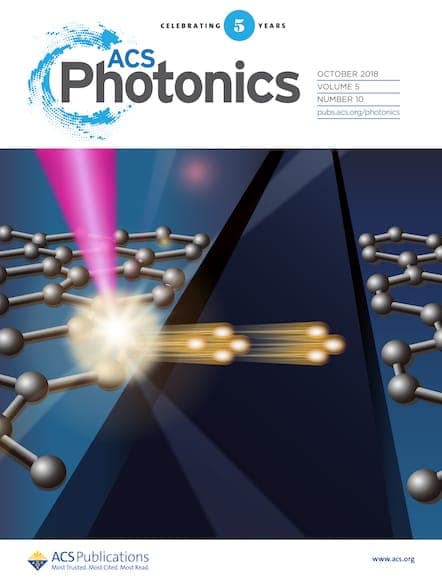The Editors of ACS Photonics are proud to announce that Maiken H. Mikkelsen, Associate Professor in the Department of Electrical & Computer Engineering at Duke University, is the winner of the 2020 ACS Photonics Young Investigator Award Lectureship. The lectureship, established in 2016, honors the contributions of a researcher, within the first 5-12 years of […]

Professor Mikkelsen received her B.S. in Physics from the University of Copenhagen in 2004, her Ph.D. in Physics from the University of California, Santa Barbara in 2009 and was a postdoctoral fellow at the University of California, Berkeley before joining Duke University in 2012. Her research explores nanophotonics and quantum materials to enable transformative breakthroughs for optoelectronics, quantum science, the environment, and human health.
In celebration of winning the Lectureship Award, we asked Maiken a few questions related to her research as well as advice for young investigators.
What does winning the 2020 ACS Photonics Young Investigator Lectureship mean to you?
I am humbled and honored to receive this award and delighted that our research is making an impact in the scientific community. It wouldn’t have been possible without a team of talented and hardworking students, postdocs, and wonderful collaborators along the way.
What made you pursue the fields of nanophotonics and quantum materials?
Since my undergraduate years, I have been fascinated by the interaction of light and matter on the deep nanoscale and quantum mechanics. Lately, I have been intrigued by how well-known materials may behave in previously unimaginable ways when their electromagnetic environment is drastically altered. This allows not only new material “building blocks” for optoelectronics and quantum information science, but also reveals a wealth of new physics.
What project is your work group most excited about right now and why?
We have a lot of really exciting projects, but one challenge that stands out is to demonstrate that the effects we are seeing are robust in the sense that they can actually be utilized in devices. Recently, we have utilized sub-10 nm gap cavities in projects ranging from spectrally-selective photodetectors to biosensors.
Can you share some advice for other young investigators?
Don’t get discouraged by setbacks; they present opportunities for creativity and problem solving, which is a lot of fun! Always remember to enjoy your research, I believe it is such a privilege to have academic freedom, choose research problems and dig deep.
***
As the winner, Professor Mikkelsen will present her award lecture during the December edition of the ACS Photonics Global Webinar Series.
Recommended Reading – Highlighting Some of Professor Mikkelsen’s ACS Photonics artices
Active Control of Multiple, Simultaneous Nonlinear Optical Processes in Plasmonic Nanogap Cavities
ACS Photonics 2020, 7, 4, 901–907
DOI: 10.1021/acsphotonics.0c00011
***
Real-Time Tunable Strong Coupling: From Individual Nanocavities to Metasurfaces
ACS Photonics 2019, 6, 4, 838–843
DOI: 10.1021/acsphotonics.8b01743
***
Tailored Emission Spectrum of 2D Semiconductors Using Plasmonic Nanocavities
ACS Photonics 2018, 5, 2, 552–558
DOI: 10.1021/acsphotonics.7b01085
***
Polarization-Controlled Nanogap Cavity with Dual-Band and Spatially Overlapped Resonances
ACS Photonics 2019, 6, 8, 1916–1921
DOI: 10.1021/acsphotonics.9b00851
